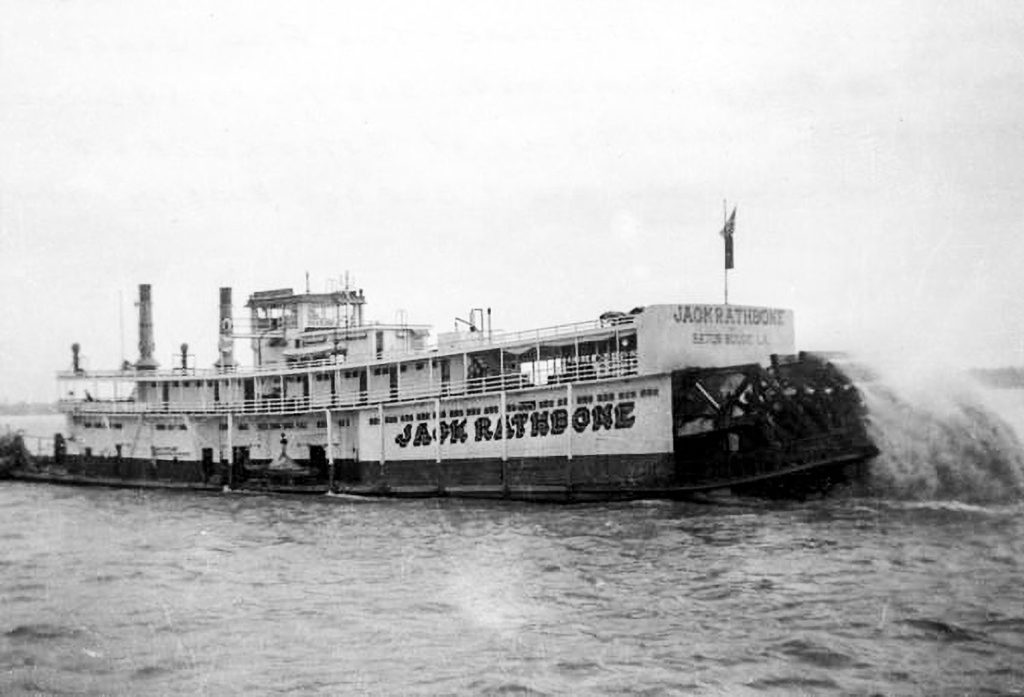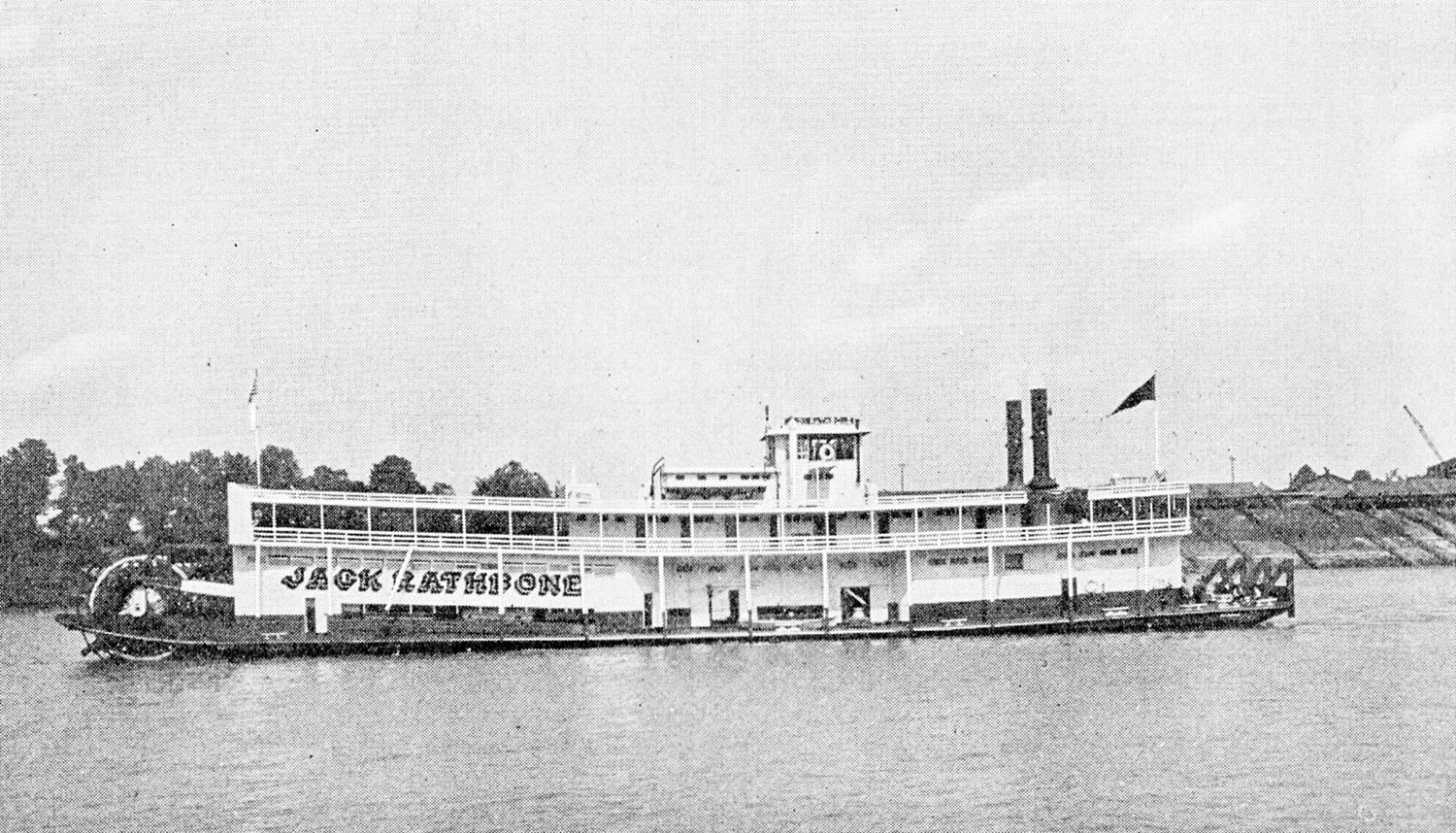While new diesel-driven towboats were making headlines in the 1930s, steam power was still king, and several significant new steamers were built in the waning days of steam construction.
The Standard Oil Company of Louisiana was one concern that relied on steam power to shove tows loaded with finished petroleum products from their refinery at Baton Rouge to points north. The Standard fleet at that time included the mammoth towboat Sprague, fabled since 1902 as the largest towboat ever built. Conceived to shepherd giant coal tows to southern regions by the Combine of Pittsburgh, it had begun a new career towing oil when first chartered to Standard in 1922 and purchased by them in 1925. Standard continued to acquire or build large steam sternwheel towboats throughout the 1920s and 1930s.
Dubuque Boat & Boiler built the Amos K. Gordon for Standard in 1933. It was 190 by 38 feet and had condensing engines that were 16’s, 32’s – 10 foot stroke. These engines had been built by the Marietta Manufacturing Company (MMC) to repower the James Moren, a wood hull sternwheeler built in 1896, after Standard bought it in 1925. The Moren was dismantled in 1932, and the engines were used for the new Gordon. The boat had two Foster-Wheeler boilers that were allowed 300 pounds of steam pressure. The boat was rated at 750 hp.
By late 1936, the refiner had a need for another large sternwheel steamboat. This time MMC would construct the whole vessel at its Point Pleasant, W.Va., shipyard.
The New Orleans News column of the May 8, 1937, issue of The Waterways Journal noted that “a modern all-welded steel towboat for the Standard Oil Company of Louisiana” had been launched by MMC, “without the usual ceremonies and without the boat being named.” It went on to say that the boat would be “one of the largest and most powerful of sternwheelers” and was designed to be operated as one of the most economical towboats for the Lower Mississippi River trade. Work had started on the new boat on December 9, 1936, and it was expected to be ready for service within 30 days. This boat had a hull that measured 190 by 42 feet, a few feet wider than the Amos K. Gordon.
The “Gallipolis Gossip” column of the June 26, 1937, WJ indicated that the new boat had been named Jack Rathbone, and that it was nearing completion at MMC. The column also said that this was one of the very few in recent years “to be built with a texas above the main cabin.” This “texas” was more of a small cabin located behind the elevated pilothouse. Fred Shearer, port engineer for Standard, was at MMC to oversee the installation of the engines and boilers. The engines were identical to those of the Amos K. Gordon, 16’s, 32’s – 10 foot stroke. Two Foster-Wheeler oil-burning water-tube boilers were placed and allowed 350 pounds of steam pressure. The boat was rated at some 1,900 hp.

The July 17, 1937, WJ reported that the new Rathbone had departed Point Pleasant at 4 p.m. on July 3 and arrived at Baton Rouge at 5 p.m. on July 9 with Capt. Robert P. Mann in command (Robert Mann light, Mile 790.3 Ohio River, is named in his honor.) On July 11, the Rathbone left Baton Rouge upbound, headed to Grand Lake, Ark., with Capt. J.W. Stephens in charge and Fred Shearer as chief engineer. It again departed Baton Rouge on July 17 on its first through trip to Louisville, Ky. An informal ceremony was held prior to this departure that was reported in the July 24 issue of the WJ. Mrs. M.J. Rathbone Jr., wife of the boat’s namesake and president of Standard of Louisiana, christened the boat with a bottle of champagne. (Rathbone, then 37, was a native of Parkersburg, W.Va.) The boat was feted as being “second in power rating for sternwheel boats only to the Sprague, fittingly honoring Mr. Rathbone’s meritorious service with the company.”
A group of company guests then enjoyed a short ride on the vessel in the local harbor before it departed. The boat had been decked out in multi-colored pennants and flags without, while inside the cabin was decorated with bouquets of fresh flowers. Two large cakes bearing the name “Jack Rathbone” were provided for the guests, and music was provided by the Standard Refinery Band. The crew aboard the boat included Capt. J.W. Stephens, master; Capt. A.L. McMurray, pilot; Richard Uhle, chief; Tony Bacalo, assistant engineer; Lester Jones, mate; and John Greaud, steersman. The round trip was expected to take some 18 days to complete.
The Jack Rathbone would be the last steam sternwheel boat built for Standard of Louisiana. It continued in service to that company, which became the Esso Standard Oil, until October 1949. At that time, it was sold to the J.D. Clark Company of New Orleans, which converted it into a dredge. It only had a career as a towboat for 12 years before being supplanted by new diesel vessels.
Caption for top photo: New at MMC with the shipyard ways in the background. Photo from an MMC ad in the July 31, 1937, WJ. (David Smith collection)
Capt. David Smith can be contacted at davidsmith1955obc@gmail.com.




